
The Shahnameh is a long epic poem written by the Persian poet Ferdowsi between c. 977 and 1010 CE and is the national epic of Greater Iran. Consisting of some 50,000 "distichs" or couplets, the Shahnameh is one of the world's longest epic poems. It tells mainly the mythical and to some extent the historical past of the Persian Empire from the creation of the world until the Muslim conquest in the seventh century. Iran, Azerbaijan, Afghanistan and the greater region influenced by Persian culture such as Georgia, Armenia, Turkey and Dagestan celebrate this national epic.

Rostam or Rustam is a legendary hero in Persian mythology, the son of Zāl and Rudaba, whose life and work was immortalized by the 10th-century Persian poet Ferdowsi in the Shahnameh, or Epic of Kings, which contains pre-Islamic Iranian folklore and history. However, the roots of the narrative date much earlier.

Tahmina or Tahmineh is a female character in the story Rostam and Sohrab, part of the 10th-century Persian epic of Shahnameh. Her name is mentioned as the wife of Rostam and as the daughter of Samanganshah, the sovereign of Samangan.
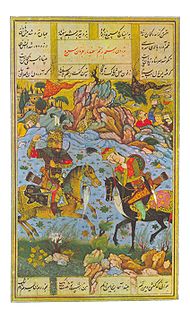
Esfandiyār or Espandiyār is a legendary Iranian hero and one of characters of Ferdowsi's Shahnameh. He was the son and the crown prince of the Kayanian King Goshtasp and Queen Katāyoun. He was the grandchild of Kay Lohrasp.

Siyâvash or Siyâvosh, is a major figure in Ferdowsi's epic, the Shahnameh. He was a legendary Iranian prince from the earliest days of the Iranian Empire. A handsome and desirable young man, his name literally means "the one with the black horse" or "black stallion". Ferdowsi, the author of the Book of Kings, (Shahnameh), names his horse Shabrang Behzād literally "night-coloured purebred".

Bijan and Manijeh is a love story in Ferdowsi's Shahnameh. Bijan was the son of Giv, a famous Iranian knight during the reign of Kay Khosrow, the Shah of Iran, and Banu Goshasp, the heroine daughter of Rostam. Bijan falls in love with Manijeh, the daughter of Afrasiab, the king of Turan and the greatest enemy of Iran. The tale of his suffering and Manizheh constancy has been quoted by several others.

Kay Khosrow is a legendary king of Iran of Kayanian dynasty and a character in the Persian epic book, Shahnameh. He was the son of the Iranian prince Siavash who married princess Farangis of Turan while in exile. Before Kay Khosrow was born, his father was murdered in Turan by his maternal grandfather Afrasiab. Kay Khosrow was trained as a child in the desert by Piran, the wise vizier of Afrasiab. His paternal grandfather was Kay Kāvus, the legendary Shah of Iran who chose him as his heir when he returned to Iran with his mother. The name Kay Khosrow derives from Avestan 𐬐𐬀𐬎𐬎𐬌 𐬵𐬀𐬊𐬯𐬭𐬀𐬎𐬎𐬀𐬢𐬵𐬀 Kauui Haosrauuaŋha, meaning "seer/poet who has good fame".

Sudabeh is a character in the Persian epic Shahnameh. She was princess of Hamavaran kingdom and later, becomes the wife of Kay Kāvus, King of Iran, and mother of prince Siyavash.

The tragedy of Rostam and Sohrab forms part of the 10th-century Persian epic Shahnameh by the Persian poet Ferdowsi. It tells the tragic story of the heroes Rostam and his son, Sohrab.
Kai Bahman or -Wahman is a mythological figure of Greater Iranian legend and lore. The stock epithet Kai identifies Bahman as one of the Kayanian kings of Iranian oral tradition.
The Borzu Nama is a Persian epic poem of about 65,000 couplets recounting the exploits and adventures of the legendary hero Borzu, son of Sohrab and grandson of Rostam.
The Seven Labors of Rustam are a series of acts carried out by the greatest of the Iranian heroes, Rostam, This story was retold by Ferdowsi in his epic poem, Shahnameh. Seven Labours, is seven difficult steps that Rostam did. In his labors, Rostam was often accompanied only by his horse, Rakhsh. In two of his labors, he was also accompanied by a champion, Olad.

Goudarz is one of the main Iranian heroes in Shahnameh, the national epic of Greater Iran, and progenitor of one of its most prominent families. He is son of Kashvad, father of Giv and Roham and the grandfather of Bizhan. His first appearance is in the time of Kay Kavus and thereafter he appears almost in every story of the heroic age, sometimes he is the spahbed of Iranian Army. His personality is described very positively with traits such as loyalty, patience and altruism.

Giv is one of the main Iranian heroes in the Shahnameh, the national epic of Greater Iran. He is one of the most famous heroes of Shahnameh. Beside Shahnameh, Giv is also mentioned in Middle Persian texts such as Bundahishn. In Bundahishn, Giv is an immortal and one of the companions of Saoshyant. Giv is son of Goudarz, brother of Roham and father of Bizhan. He married with Banu Goshasp, the daughter of Rostam. Giv appears almost in every story of the heroic age and he is sometimes the spahbed of Iranian Army.
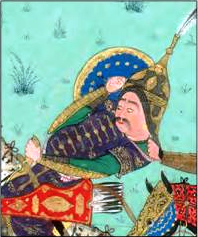
Gorgin is an Iranian hero in Shahnameh, during the reigns of Kay Kavus and Kay Khosrow. He is son of Milad. According to Tabari, the name of Milad's father is also Gorgin, which is possible because in ancient Iran, it was a usual practice to name the first grandson after the grandfather. Beside Shahnameh, Gorgin also appears in other Iranian epics such as Faramarz Nama and Bahman Nama.
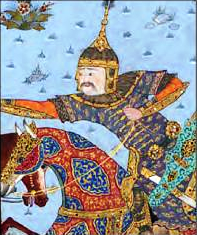
Gostaham is the name of a number of Iranian heroes in Shahnameh.
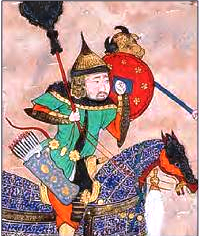
Houmān not to be confused with Houman, is one of the most famous Turanian heroes in Shahnameh, the national epic of Greater Iran. Houmān is famous for his bravery, loyalty, and chivalry, such that even Iranians who are longtime enemies of Turanians admire his personality. He is a descendant of Tur, a son of Viseh and brother of Piran. Houmān is the highest ranking Turanian commander and after Piran, he is the second leading member of Viseh clan. Houman first appears in the story of Rostam and Sohrab, where Afrasiab sends him with an army of 12,000 men to accompany Sohrab in his journey to Iran. He has been instructed by Afrasiab to not let Sohrab recognize his father, Rostam, so that they fight together and one of them kill the other. Rostam on the deathbed of Sohrab, agreed to promise that he would not hurt Houmān and his army.
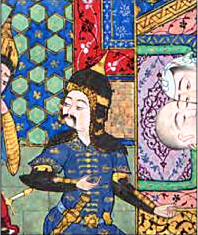
Bahram is an Iranian hero in Shahnameh, the national epic of Greater Iran. He is son of Goudarz and brother of Rohham, Giv and Hojir. In the story of Siavash, he and Zange-ye Shavaran are Siavash's counselors. They unsuccessfully try to convince Siavash not to go to Turan. When Siavash goes to Turan and abandons Iranian army, Bahram is put in command of the Iranian army until the arrival of Tous. His most important adventure is in the story of Farud, where he fights with Turanian army along with other Iranian heroes. When Iranian army is marching toward Turan, they encounter Farud, who along with Tokhar (تُخوار) are standing on a mountain. Tous, the spahbed of Iranian army does not know Farud and think that he is a Turanian foe. He sends Bahram to go there and kill both of them. When Bahram arrives at Farud, Farud introduces himself and says that he is son of Siavash and want to avenge Afriasiab. Bahram comes back to Tous and tells him that they are not enemy and instead they want to join Iranian army to fight against Afrasiab. Tous, however, does not believe this and orders to kill Farud. Bahram unsuccessfully tries to restrain Tous and Iranians from killing Farud and his companion. However, Farud was eventually slain by Rohham and Bizhan.
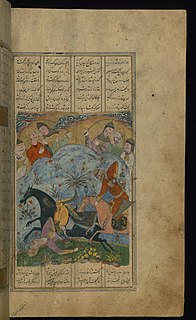
Zavara or Zavareh is an Iranian hero in Ferdowsi's Shahnameh. He was brother Rostam and son of Zal and played an important role in the Iranian invasion of Turan after murder of Siyavash by the command of the Turanian king, Afrasiyab. It is said that Zavara killed the Turanian prince Sokhra in the way that the Turanians killed the Iranian prince Siyavash.
And Zavara left the camp [to fight with them], with the god's help and with the shah's will.

Bârmân In the Great War of Iran and Turan the time of Nowzar was. In this war he was of the and one of the commanders of the Afrasiab. Iran-Turan war It happened after Manuchehr death. Until then, Turanian did not dare attack Iran. But after the death of Nowzar Turanians had the opportunity to attack Iran. The King of Iran was killed in the attack and a large part of the country was occupied.





















